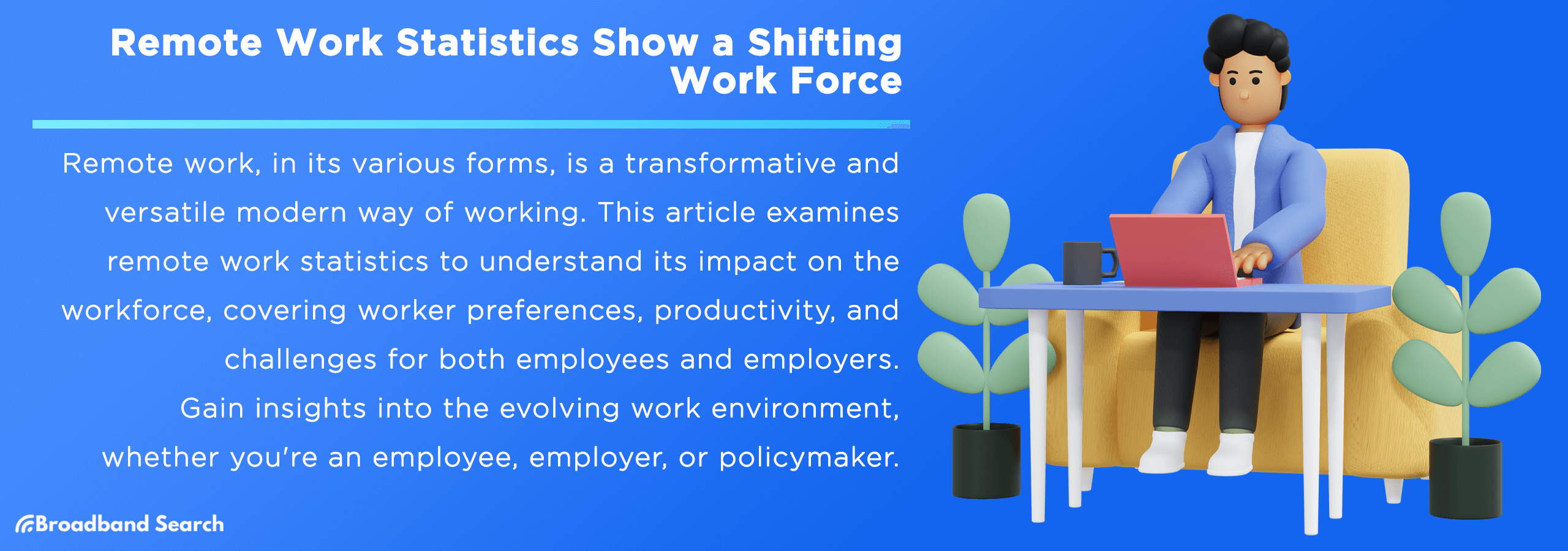Remote work, in its various forms - full-time remote, hybrid arrangements, and occasional remote work, has emerged as a transformative and versatile way of working in the modern era. Its historical roots lie in efforts to reduce commuting and alleviate urban congestion, but today, it plays a pivotal role in the professional landscape.
This article analyzes a range of remote work statistics to provide a comprehensive understanding of how remote work is reshaping the workforce. From remote worker preferences to productivity impacts and challenges faced by both employees and employers, we'll explore the data that reveals the ongoing transformation in work. By the end of this article, you'll gain valuable insights into the evolving work environment, whether you're an employee seeking work-life balance, an employer adapting to remote work, or a policymaker navigating labor regulations.
Remote Work Trends
Historical Trends and Pre-pandemic Data
Before the COVID-19 pandemic, remote work was already on the rise, albeit more gradually. Here are some key statistics:
Pre-Pandemic Remote Work Prevalence: Pre-pandemic, remote work gradually gained traction, with a significant percentage of employees already embracing this flexible work arrangement. A Gartner, Inc. survey conducted in April 2020 among 229 HR leaders highlighted that 30% of employees surveyed had experience working remotely at least part of the time. Moreover, Statista's recent findings indicate that pre-pandemic, approximately 17% of U.S. employees enjoyed the flexibility of working from home for five days or more per week.
Industry Variations: In the last two decades, the proliferation of digital technologies and information and communication technologies (ICTs) has created an environment conducive to the adoption of remote work across various organizations and entrepreneurial ventures. However, it's important to note that, prior to the COVID-19 pandemic, remote work remained a recognized but relatively underutilized practice.
A recent study from the National Institute of Health (NIH) underscores this point, revealing that before the pandemic hit, emergency remote work was only embraced by a relatively small percentage of the workforce. Specifically, it found that approximately 2.9% of the total U.S. workforce and around 2% of the European workforce were engaged in remote work due to emergency situations.
Impact of COVID-19
The COVID-19 pandemic has fundamentally reshaped the way we work, with the most notable change being the surge in remote work. Before the pandemic, only around 5% of full-time office employees primarily worked from home. However, the "new normal" is expected to see a substantial increase, potentially reaching 20-30% of the workforce working remotely.
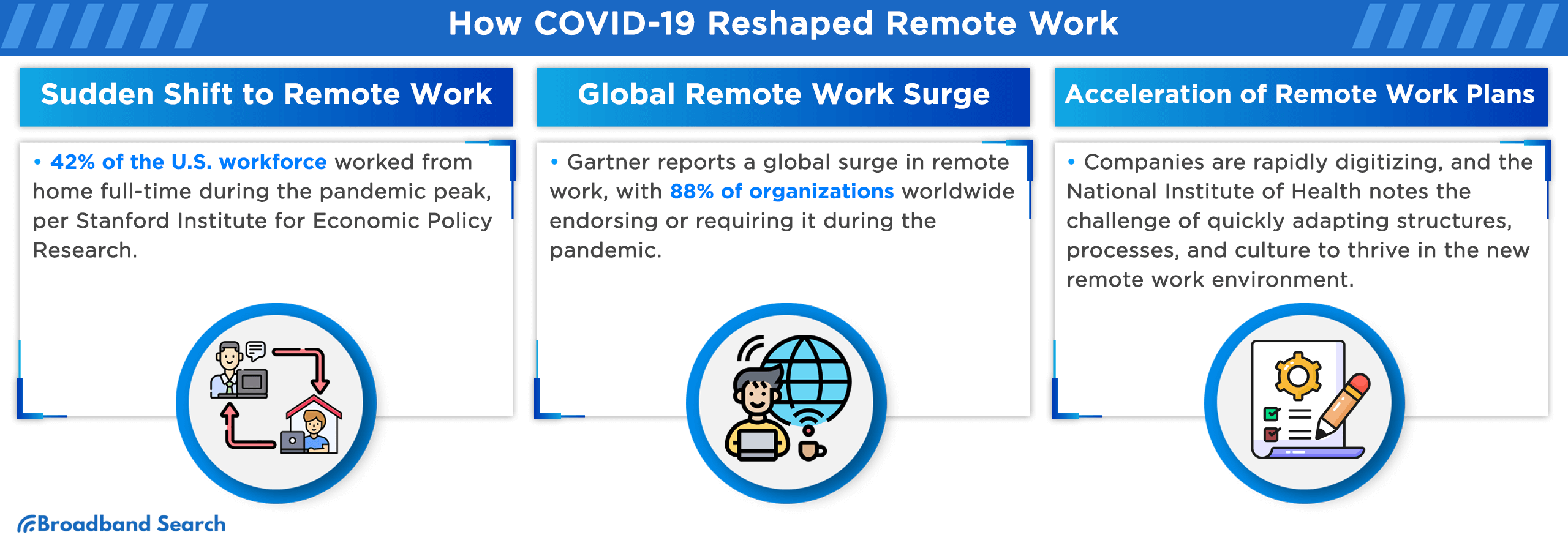
- Sudden Shift to Remote Work: At the height of the pandemic, approximately 42% of the U.S. workforce was working from home full-time according to a study by Stanford Institute for Economic Policy Research.
- Global Remote Work Surge: Globally, remote work experienced a surge, Gartner reveals that 88% of organizations worldwide are encouraging or mandating remote work during the pandemic.
- Acceleration of Remote Work Plans: The National Institute of Health (NIH) has shed light on how companies expedited their digitalization efforts at an unprecedented pace. However, this swift implementation of digital technologies left many organizations with minimal time to make necessary adjustments to their structures, processes, and corporate culture to effectively operate in this new environment.
Recent Remote Work Statistics
In the post-pandemic landscape, remote work continues to be a prominent feature of the workforce:
Percentage of Remote Workers: Remote work has seen rapid normalization, with approximately 12.7% of full-time employees currently working from home, according to recent Forbes findings. Simultaneously, a substantial 28.2% of employees have embraced a hybrid work model, striking a balance between home and in-office work. This hybrid approach provides both flexibility and the benefits of maintaining some physical presence in the workplace.
Growth Rate of Remote Work: Remote work opportunities have witnessed a remarkable surge in growth, as per Forbes. These opportunities, which were previously limited to less than 4% of high-paying jobs before the pandemic, expanded to encompass approximately 9% by 2020. Today, they have surpassed the 15% mark, underscoring a substantial and enduring transformation in how work is conducted.
Industry-Specific Trends: The pandemic has ignited an unprecedented surge in work-from-home job opportunities. In April, a staggering 12.4% of all paid job listings on LinkedIn were for remote positions. This surge is particularly pronounced in five key sectors:
- Technology: Remote job listings in the technology sector constitute a substantial 41.2% of all listings.
- Education: The education sector has seen a significant embrace of remote work, with 29.0% of job listings being remote.
- Administrative and Support Services: In this sector, 27.4% of job listings offer remote work options.
- Professional Services: Approximately 26.5% of job listings in professional services now come with remote work possibilities.
- Financial Services: The financial services sector is also adapting, with 20.2% of job listings now being remote.
Notably, Pumble reported that companies in the public administration sector were the least likely to offer full-time remote work options, with only 25% providing this flexibility.
Employee Preferences and Satisfaction
Remote Work Preferences
Recent data from Forbes underscores the remarkable appeal of remote work, with 65% of workers expressing a desire to work remotely full-time. This statistic reveals a strong and growing preference for remote work arrangements.
Moreover, a staggering 98% of workers expressed the desire to incorporate remote work into their schedules, even if only partially. This near-unanimous interest highlights the widespread acceptance of remote work as a valuable option for today's workforce.
However, it's worth noting that preferences vary, and a study by Gallup found that 65% of respondents favor a hybrid work model, blending remote and in-office work. Nevertheless, the desire to exclusively work from home has doubled since October 2021, showcasing the evolving dynamics of work preferences.
Factors Influencing Preferences
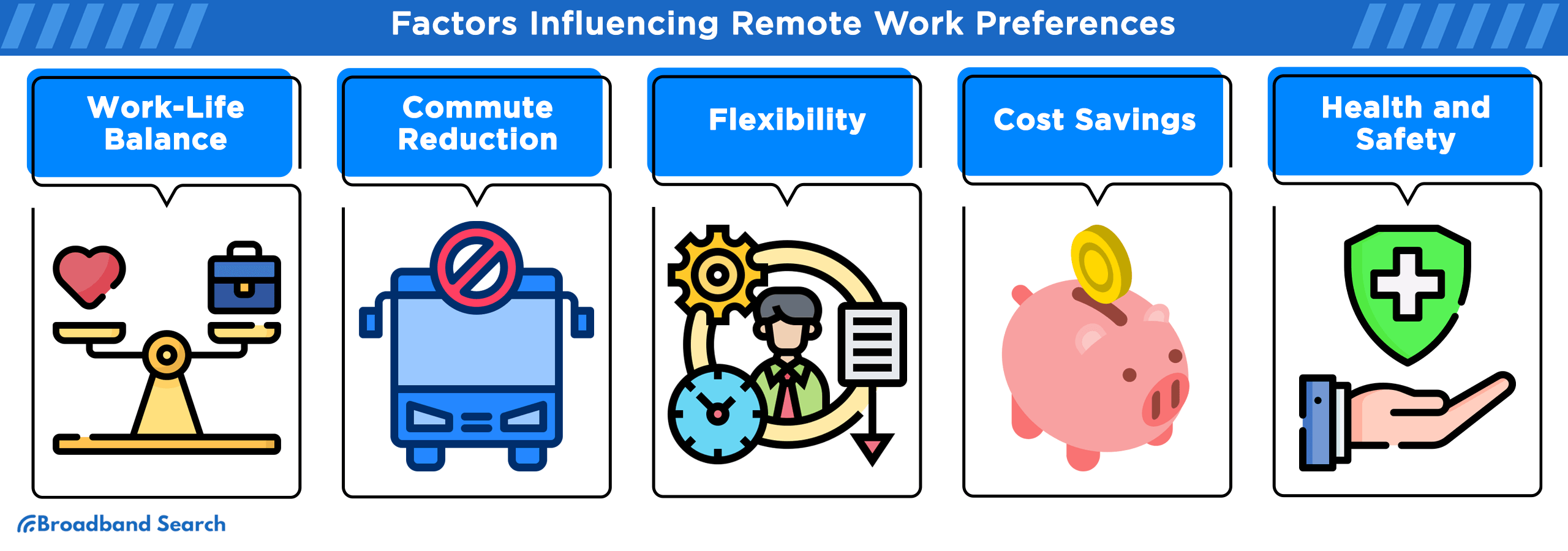
1. Work-Life Balance
Achieving a healthier work-life balance stands out as a pivotal motivator behind the preference for remote work. An insightful market survey conducted by Great Place To Work® with nearly 4,200 full- and part-time employees offers compelling evidence. It reveals that remote workers consistently report higher levels of work-life balance, as well as improved psychological and emotional well-being.
In this survey, a remarkable 63% of remote workers reported experiencing a healthy work-life balance. In contrast, this percentage drops slightly to 59% for hybrid employees and further to 57% for in-person workers.
2. Commute Reduction
Long commutes have long been a significant concern for employees, and this sentiment is echoed consistently in employee surveys. Take, for instance, findings from a recent Pumble survey, which highlight a noteworthy aspect of remote work. Approximately 59% of work-from-home employees express that they now enjoy more free time precisely because they no longer have to endure daily commutes to the workplace.
3. Flexibility
The desire for flexibility in work arrangements is a prominent trend. According to the Summer 2022 Future Forum Pulse, an astonishing 94% of workers express a strong preference for flexibility in determining their work hours. This figure stands in contrast to the 80% of respondents who seek flexibility in choosing their work location.
4. Cost Savings
Remote work not only offers convenience but also potential cost savings, a factor often appreciated by employees. Beyond eliminating the daily commute, surveys have revealed that remote workers experience reduced expenses associated with transportation and professional attire.
For example, data from FlexJobs shows that individuals who work from home half the time can realize savings of approximately $4,000 annually. This encompasses a range of expenses, including gas, car maintenance, transportation fees, parking costs, expenditures on a professional wardrobe, and even daily lunch expenses that can be significantly reduced or entirely eliminated.
5. Health and Safety
The COVID-19 pandemic has brought health and safety concerns to the forefront, making remote work a preferable option for many employees concerned about their well-being.
Job Satisfaction Among Remote Workers
Recent findings from a collaborative Global Work-Life Survey conducted in partnership with Remote, the Future Workforce Alliance, and IE Business School reveal a notable disparity in job satisfaction levels between remote and in-office workers.
In this survey, it was discovered that 41% of employees who work exclusively in an office environment are currently experiencing burnout, a significantly higher percentage compared to the 26% of remote workers facing burnout.
Furthermore, job satisfaction levels highlight the positive impact of remote work. An impressive 65% of remote workers reported being "extremely satisfied" with their jobs, a striking contrast to the 34% of office-based employees who expressed the same level of job satisfaction.
Productivity and Performance
Remote Work and Productivity
Remote work productivity is a critical aspect of employees' experiences, and it's notable that perceptions vary among individuals. According to insights from Pumble, roughly 11% of employees express feeling less productive when working remotely. However, a substantial 62% believe that remote work has, in fact, enhanced their productivity.
For many, productivity is a determining factor in their remote work preferences. Forbes reports that 35% of remote employees specifically feel more productive when working in a fully remote capacity. These varying perspectives on productivity underscore the importance of individual work styles and conditions when considering remote work arrangements.
Factors Impacting Remote Work Productivity:
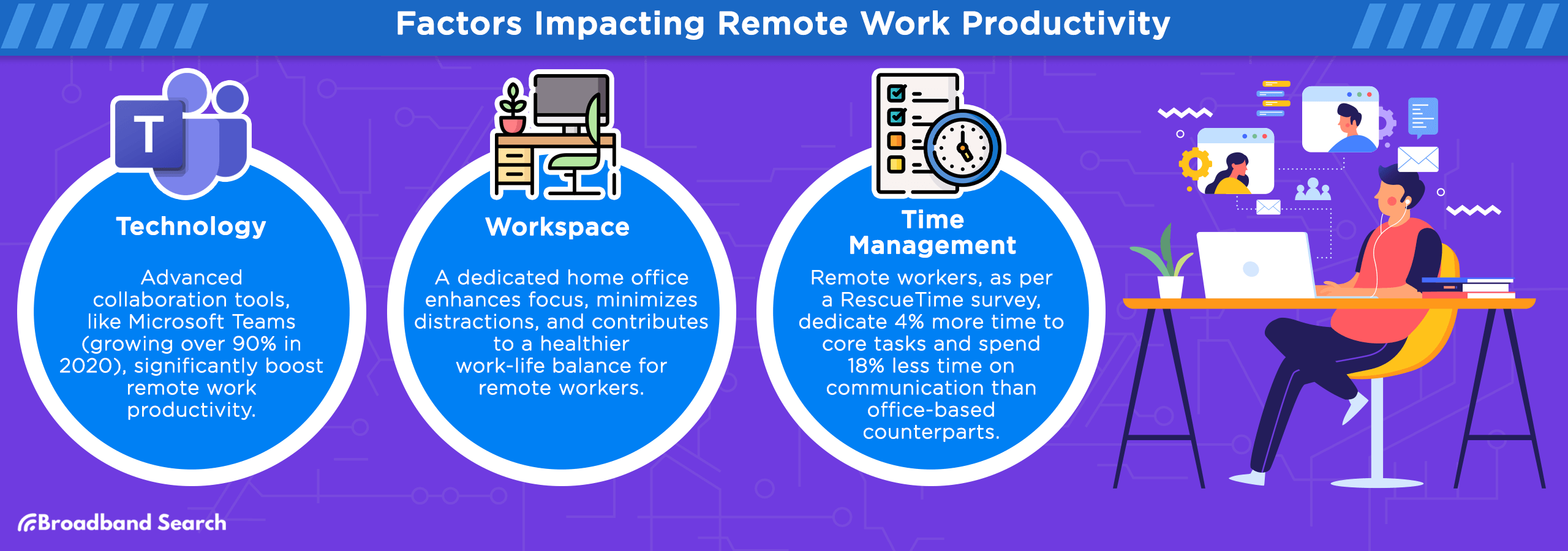
- Technology: Effective use of technology tools plays a significant role in remote work productivity. Employees using advanced collaboration and project management software often report better productivity. For instance, Microsoft Teams experienced exceptional growth in 2020, surging by over 90% in response to the pandemic. By 2021, it boasted an impressive 145 million daily active users.
- Workspace: Studies consistently emphasize the positive impact of having a dedicated workspace or home office when working remotely. Such spaces minimize distractions and facilitate better concentration, ultimately contributing to increased productivity. Additionally, a well-structured workspace promotes a healthier work-life balance, helping individuals delineate their professional and personal lives more effectively.
- Time Management: Effective time management skills play a pivotal role in remote work success. A revealing survey conducted by RescueTime demonstrates that remote workers exhibit a 4% increase in their average daily time dedicated to core work tasks. Intriguingly, they also demonstrate an 18% reduction in time spent on communication compared to their office-based counterparts.
Employee Performance Evaluations
Assessing employee performance in the context of remote work reveals intriguing dynamics. A study conducted by the Harvard Business Review sheds light on the productivity aspect. Initially, when employees embraced work-from-home (WFH) policies, their productivity surged impressively by 13%. However, what sets this study apart is its long-term perspective.
Nine months later, when the same employees faced the choice between staying at home or returning to the office, those who continued to work remotely experienced even more substantial performance improvements. Their productivity registered a remarkable 22% increase compared to their pre-experiment performance. These findings underscore the significant and sustained positive impact of remote work on employee performance evaluations.
Furthermore, remote work's influence on performance extends beyond the individual. According to a survey by ConnectSolutions, a substantial 77% of individuals who engage in remote work at least a few times each month report increased productivity. Within this group, 30% achieve more work in less time, while 24% maintain their previous output within a shorter timeframe.
Adding to this, insights from the State of Remote Work report by Buffer reveal overwhelming support for remote work. An astounding 97% of respondents in this survey express a readiness to recommend remote work to others.
Challenges and Concerns
Remote Work Challenges
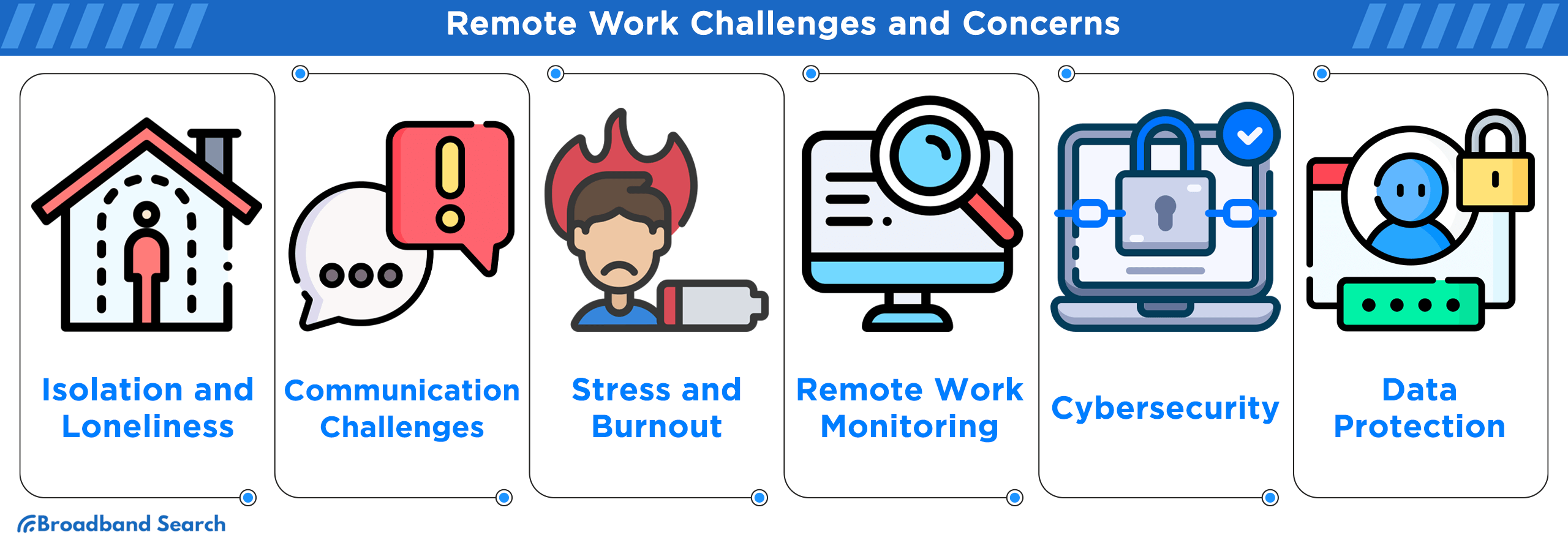
Isolation and Loneliness: The experience of isolation and loneliness is a common challenge faced by remote workers. The absence of regular social interactions can lead to these feelings. Notably, Microsoft's report highlights that a significant 50% of remote employees feel lonelier at work when transitioning to a hybrid or remote work model.
Communication Challenges: Remote work indeed poses unique communication challenges. Apart from issues like loneliness and distractions at home, effective collaboration and communication can be among the most significant hurdles. Surprisingly, 16% of employees working from home report struggling with seamless collaboration and communication with their team members.
Stress and Burnout: Remote work has been linked to elevated levels of stress and burnout, posing significant challenges to employee well-being. Recent statistics highlight the severity of these concerns. A substantial 86% of employees engaged in full-time remote work report experiencing burnout, underscoring the strain associated with remote work setups. Furthermore, a significant 67% of remote workers feel compelled to be available around the clock, contributing to heightened stress levels and work-related pressures. Additionally, nearly half, or 48%, of remote workers feel a distinct absence of emotional support from their employers, exacerbating feelings of isolation and stress.
Employer Concerns
Remote Work Monitoring: Employers' apprehensions regarding the monitoring of remote employees' productivity have escalated as remote work becomes the norm. With the rise of digital tools such as desktop monitoring and video surveillance, companies aim to curb rule-breaking behavior. However, recent research has revealed unexpected outcomes.
For instance, a Harvard Business Review study uncovered that monitored employees were considerably more prone to rule-breaking activities. These behaviors included instances of cheating on tests, equipment theft, and deliberately slowing down their work pace. This phenomenon raises questions about the efficacy of such monitoring systems and their unintended consequences.
Contrastingly, a 2020 Gartner survey brings forth a different perspective. It suggests that organizations offering employees flexibility in terms of when, where, and how much they work to witness a substantial 55% of their workforce categorized as high performers. This data underscores the potential benefits of trust-based, flexible work arrangements that prioritize outcomes over surveillance, providing an alternative approach to optimizing remote employee productivity.
Cybersecurity: Safeguarding data and fortifying defenses against cyber threats remains a paramount concern in the era of remote work. Pertinently, research from CyberTalk.Org highlights the stakes, revealing that 20% of organizations have fallen victim to data breaches linked to remote workers.
These breaches not only compromise security but also entail unforeseen financial implications. The report further underscores the financial toll, with 24% of respondents acknowledging that their organizations incurred unexpected expenses to rectify breaches or combat malware attacks.
Data Protection: The landscape of remote work has introduced novel challenges in the realm of data privacy and security. Employers have valid concerns about safeguarding sensitive data in these decentralized work environments. This concern extends to ensuring that proprietary information and confidential data remain protected even when employees work remotely. In this context, it becomes imperative for organizations to implement robust data protection measures, which may include secure access protocols, encryption, and ongoing employee training in data security best practices.
Impact on Real Estate and Office Spaces
Reduced Office Space Demand
The demand for office space in the United States has witnessed a significant decline. Recent data from The Ivy Group indicates that in the first quarter of 2023, office leasing volume plummeted to 38.5 million square feet. This marks the third consecutive quarter of diminishing demand, with a stark 9.8% drop compared to the previous quarter in 2020. Additionally, leasing activity for this period was 10.7% lower than the figures recorded in the final quarter of 2022.
Remote work and companies' decisions to downsize their physical presence in anticipation of slower economic growth have left a substantial footprint on the availability of office space in the United States. The latest data from FDI Intelligence reveals that the consequences are profound.
In the first quarter of 2023, average office vacancy rates in the U.S. national market reached an unprecedented 18.6%. This figure represents a significant 5.9 percentage-point increase from the last quarter of 2019, as projected by Cushman & Wakefield, a prominent commercial real estate services company. Simultaneously, the supply of new office space across the U.S. amounted to 4.54 million square feet in the first quarter of the year, which is approximately only 21.5% of the level observed in the last quarter before the onset of the COVID-19 pandemic.
Office Redesign and Flexible Workspace Trends
Adoption of Flexible Office Solutions: Businesses are rapidly embracing flexible office solutions as a strategic real estate move. According to research conducted by The Economic Times, flexible office spaces have surged to the forefront of short-term real estate portfolio strategies. An impressive 47% of corporate entities express intentions to expand their utilization of flexible office spaces in the coming 12 months.
Changes in Office Design: The transition towards flexible workspace solutions has ignited a transformation in office design and layout. Architecture and design firm NBBJ, for instance, is actively exploring the optimal design for hybrid work settings. In this endeavor, they have adopted a workspace nearly twice the size of their previous office. The new space, characterized by abundant natural light and soothing dark green tones, transcends the conventional office ambiance, resembling more of a "cool Airbnb" environment rather than a traditional office setup.
Future Predictions and Adaptations
Future of Remote Work
Expert Predictions: Forecasts from experts strongly suggest that remote work will remain a prominent fixture in the workforce landscape. A prime illustration of this trend can be found in the Gartner survey, which unveils that a notable 82% of company leaders are planning to incorporate remote work into their strategies, permitting employees to work remotely on a regular basis.
Long-Term Impact: The long-term impact of remote work is expected to reshape how organizations operate. It's speculated that remote work will lead to a more geographically dispersed workforce, impacting recruitment, retention, and office space demands.
Adaptations and Strategies
- Company Adaptations: Companies are adapting to remote work trends in various ways. Tech giants like Facebook and Google are embracing hybrid work models. Many are investing in advanced collaboration tools and virtual team-building activities.
- Case Studies: Real-world examples, such as Shopify's decision to become a "digital by default" company, showcase how businesses are successfully embracing remote work. Case studies like these provide insights into the strategies employed by organizations.
- Practical Advice: Practical advice for businesses includes developing clear remote work policies, ensuring strong cybersecurity measures, and offering resources for remote employees to enhance their well-being and productivity. Businesses are also encouraged to maintain open communication channels and leverage technology to bridge the physical distance among remote teams.
The Bottom Line
Remote work has transformed the workforce, as evidenced by key statistics and trends presented here. Before the pandemic, remote work was a rarity, but COVID-19 changed that dramatically. Now, a substantial portion of employees prefer working remotely at least part of the time, and flexible office solutions are on the rise.
For businesses and employees, these shifts hold crucial implications. Companies should adapt by creating strong remote work policies, prioritizing cybersecurity, and rethinking office spaces. Employees need to develop remote work skills, maintain work-life balance, and seek support when needed.
In this remote work-centric world, adaptability is vital. By understanding and embracing these trends, both businesses and employees can navigate this new landscape effectively and thrive in the evolving workforce.
FAQ
Is working from home good for your mental health?
While loneliness and isolation are acknowledged problems in working from home, a greater number express increased happiness with work.
What are the disadvantages of working remotely?
Everyone’s list might differ but here are five of the most-mentioned disadvantages to remote work: home-based distractions, loneliness, motivation, technical problems, and collaboration issues.
How do you evaluate a remote employee?
Managers quickly realized that they didn’t have the skill set to evaluate the effectiveness and productivity of their remote team members. They needed to be quick learners. Since you can’t literally watch them (illegal) on a camera, here are a few suggestions that have proven helpful:
- Set clear objectives/goals
- Use a tracking tool
- Evaluate by output rather than input
- Gather feedback from coworkers
- Ask for a self-evaluation
Are there industries or jobs that are better suited to remote work?
While remote work is possible in many industries, jobs that primarily involve computer-based tasks, data analysis, writing, programming, and other knowledge work are often more adaptable to remote work. However, even industries traditionally reliant on physical presence are exploring remote work options.
What skills are essential for remote work success?
Essential skills for remote work include effective communication, time management, self-discipline, and the ability to work independently. Proficiency in digital tools and technologies is also important.

